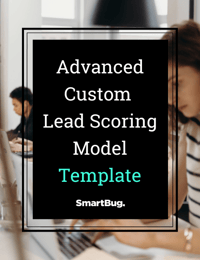
By Mike Wolfe
As soon as you implement inbound marketing, it’s very likely that you’ll begin seeing new leads enter your sales funnel. Once you do, you need a way to figure out which leads are ready to buy and which are still learning about their options. You can do so with lead scoring.
Lead scoring is the process of assigning numerical values to every lead. Usually, leads are scored based on multiple factors, including their professional information or how they’ve interacted with your website and brand. This helps sales and marketing teams prioritize leads, respond appropriately, and increase the rate of leads to customers.
Many marketing teams choose to score leads differently. As a lead marketer, you know who your company seeks to do business with. And yet, with an underdeveloped lead scoring model, it’s still possible to overestimate or underestimate a lead becoming a customer.
For this reason, we created a more advanced lead scoring model that fills in the gaps missed by basic models. It’s worked for us, and we highly recommend that you check out the document at the end of this article to use it as a starting point.
Basic Lead Scoring: What It Is and How It’s Limited
As a disclaimer, we use HubSpot for our customer relationship management (CRM) platform and utilized their basic lead scoring model to develop our own. For this reason, we will discuss how lead scoring models work in HubSpot, but many of the ideas could be applied to other CRMs.
When using the lead scoring model in HubSpot, leads receive an overall HubSpot score that is used by sales to prioritize their pipeline. Scores are determined based on applying points to Positive Criteria and Negative Criteria that help qualify contacts, companies, and deals. Generally, Positive Criteria align with your target customer and Negative Criteria divert from the target customer.
Limitations of Basic Lead Scoring
Although basic lead scoring can provide you with an idea of a prospect’s fit as a customer, this approach leaves out too much information:
- Basic lead score (HubSpot Score) alone doesn’t provide much insight into the prospect. Is the person contacting you a decision maker at the company? Who knows.
- Basic lead score alone doesn’t guarantee the prospect is a valuable lead or a good overall fit as a customer. The prospect might have a positive engagement rate with your sales team, but how good are they as a fit, for a customer?
Because of this lack of information, you might start to see far more positive scores that aren’t necessarily real leads. This can result in a flooded prospecting queue or list that is too long for sales reps to manage. A lot of time can be wasted on engaging with leads that end up being lower quality because they aren’t decision makers.
Advanced Lead Scoring: What It Is and How It Works
Advanced lead scoring combines a Fit Score and an Engagement Score to provide sales teams with more context for leads in the pipeline:
- A Fit Score determines how close a prospect comes to a match. This is determined by several attributes including revenue, vertical, industry, and ideal customer profile match. Once the Fit Score is determined, it doesn’t change.
- An Engagement Score is determined by how often a prospect is engaging with you through filling out forms, reading emails, and so on. Unlike the Fit Score, the Engagement Score can fluctuate depending on how often they’re interacting with your content.
Keep in mind that Fit and Engagement Scores are implemented in HubSpot through custom properties based on your ideal customer and engagement attributes.
By understanding a prospect’s general fit and engagement, sales teams can better prioritize and accelerate their pipeline by reaching out to prospects that are more likely to be a good fit and already engaged with content, marketing emails, or the website.
From a lead gen perspective, Fit and Engagement Scores can help marketers determine the best way to engage a database with new campaigns and messaging to increase the pipeline quality for sales.
Let’s take a look at two examples:
- Example 1: If the majority of contacts in the database have a low Fit Score but decent Engagement Scores, more effort can be made to attract new contacts who are a better fit, perhaps from specific channels that existing high-fit contacts typically come from.
- Example 2: If the Fit Scores are typically high but Engagement Scores are low, more effort can be put toward getting those high fit contacts engaged with content, marketing emails, or specific pages on the website.
Once the scoring criteria is defined and automated workflows that assign the scores are activated, all contacts in the database will have an overall rating that can be used for prospecting, lead reporting, or other purposes. This rating will update automatically as prospects become more or less engaged over time (depending on the specific score criteria).
Use Our Template for Advanced Lead Scoring Implementation Steps
Taking the steps toward advanced lead scoring is fairly simple. On your end, you need to conduct the proper research into your ideal customer profile and develop a step-by-step process in your CRM to ensure your lead scoring model accounts for every nuance in the process.
Lucky for you, we have this last part covered. Based on our own experience developing an advanced lead scoring system, we created a Leading Scoring Template that you can access for free. Give it a shot today

About the author
Mike Wolfe is a Project Strategist at SmartBug Media helping clients find success through inbound marketing. Read more articles by Mike Wolfe.









-2.png?width=800&length=800&name=Blog%20header%20image%20(1)-2.png)